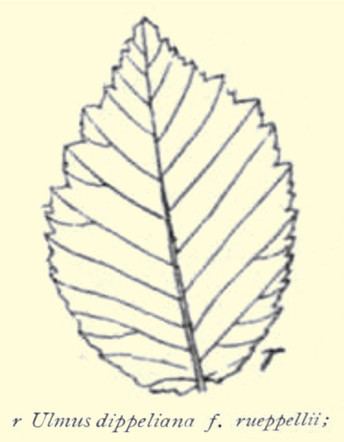Cultivar 'Rueppellii' | Origin Europe | |
 | ||
People also search for Ulmus laevis 'Punctata' | ||
Ulmus minor 'Rueppellii' is a Field Elm cultivar said to have been introduced to Europe from Tashkent by the Späth nursery, Berlin. Noted in 1881 as a 'new elm', it was listed in Späth Catalogue 73, p. 124, 1888–89, as Ulmus campestris Rueppelli, and later by Krüssmann [1] as a cultivar.
Contents
Description
'Rueppellii' was a pyramidal tree with a single stem and numerous ascending branches forming a globose or ovoid crown, much like 'Umbraculifera'. The branches are slightly corky, and the branchlets pubescent, bearing small leaves similar to those of the Cornish Elm. The leaves were said to measure 6–7 cm long by 4–5 cm wide.
Pests and diseases
A specimen at the Ryston Hall [2], Norfolk, arboretum, obtained from the Späth nursery before 1914, was killed by the earlier strain of Dutch elm disease Ophiostoma ulmi prevalent in the 1930s.
Cultivation
No specimens are known to survive. One tree was planted as U. campestris 'Rueppelli' in 1897 at the Dominion Arboretum, Ottowa, Canada. Two specimens were grown at Kew Gardens before the First World War, obtained from the Barbier nursery, France. Three specimens supplied by the Späth nursery to the Royal Botanic Garden Edinburgh in 1902 as U. campestris 'Rueppelli' may survive in Edinburgh, as it was the practice of the Garden to distribute trees about the city (viz. the Wentworth Elm). The current list of Living Accessions held in the Garden per se does not list the plant. An unidentified suckering Field Elm cultivar in Links Place, Leith Links (2016), matches the description, leaf-drawing and herbarium specimen of 'Rueppellii', and may be one of the three. Similar elms appear in old photographs of Tashkent.
Etymology
The tree is named either for Julius Rüppell, owner of the Peter Smith & Co nursery in Hamburg during the latter part of the 19th century, or for the naturalist and explorer Eduard Rüppell.
Accessions
None known.
